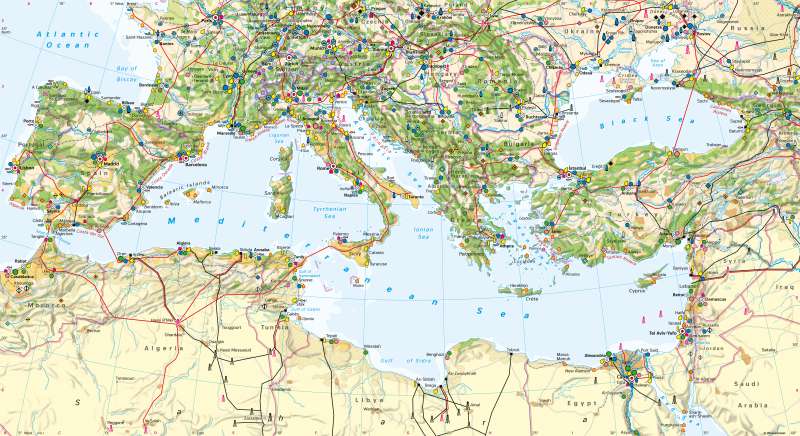The Mediterranean - Economy, land use and tourism
Economy, land use and tourism
978-3-14-100890-6 | Page 108 | Ill. 1

Overview
Several economic regions can be distinguished in the Mediterranean region, but they are also heterogeneous themselves. This economic map focuses not only on industrial locations, but also on service centres and tourism regions.
Industries and services in the Mediterranean
The north-west of Italy around the triangle of cities Milan - Turin - Genoa is one of the economically strongest regions in Europe, while the southern parts of Italy are among the economically underdeveloped, structurally weak regions.
In Spain, some old industrial districts, which owe their development to the former wealth of mineral resources, have undergone a similar process of structural adjustment as the districts in Central Europe. New industrial and service centres of international importance have concentrated around Madrid, Barcelona, and Bilbao. Apart from tourism, important pillars of the Spanish economy are construction, communications and information technology, mechanical engineering, agriculture, and the automotive industry.
The latter also plays an important role in France and Italy. In addition, both countries still have an important textile and clothing industry, which has specialised in the production of high-quality products due to the high international competitive pressure.
The aerospace industry is one of those "high-tech" industries that have gained strongly in importance in France, Italy, and Spain. The electrical engineering and electronics sectors are mainly found in agglomerations (for example Rhône-Alpes, Lombardy), which are characterised by a highly diversified, highly developed industrial structure.
In Greece, tourism has developed into one of the most important economic sectors after the state crisis. The country's export goods include above all oil, refinery, and chemical products.
Turkey occupies a middle position between the EU and the Middle East. The main focus of the Turkish economy is on the textile, vehicle, machinery, electrical and chemical industries. Locations concentrate on the Mediterranean and Black Sea coasts. In the south-east of the country, development efforts have been underway since the 1980s (South-East Anatolia Project, GAP for short), but these have hardly been able to reduce the pronounced west-east divide within the country. On the other hand, the development of the Mediterranean coasts for tourism is well advanced.
Syria's economy, which focuses on oil, textiles, and food, has been severely weakened by the civil war and the collapse of state structures. Lebanon, an important trading partner, is also suffering as a result, especially since tourism there has almost completely collapsed. Israel, on the other hand, is a diversified, export-oriented high-tech industrial country with significant gas deposits. The most important urban areas are around Tel Aviv, Haifa, and Jerusalem.
The networks of oil and gas pipelines in North Africa and the locations of oil refineries and chemical industries indicate their importance for countries such as Algeria, Libya, Tunisia and Egypt. In many places, the textile and food industries dominate, but the areas where profitable agricultural cultivation is possible are limited to a comparatively narrow coastal strip and a few oases. All North African countries suffer from the fact that tourism has plummeted or is repeatedly subject to strong fluctuations as a result of domestic unrest and Islamist attacks.




